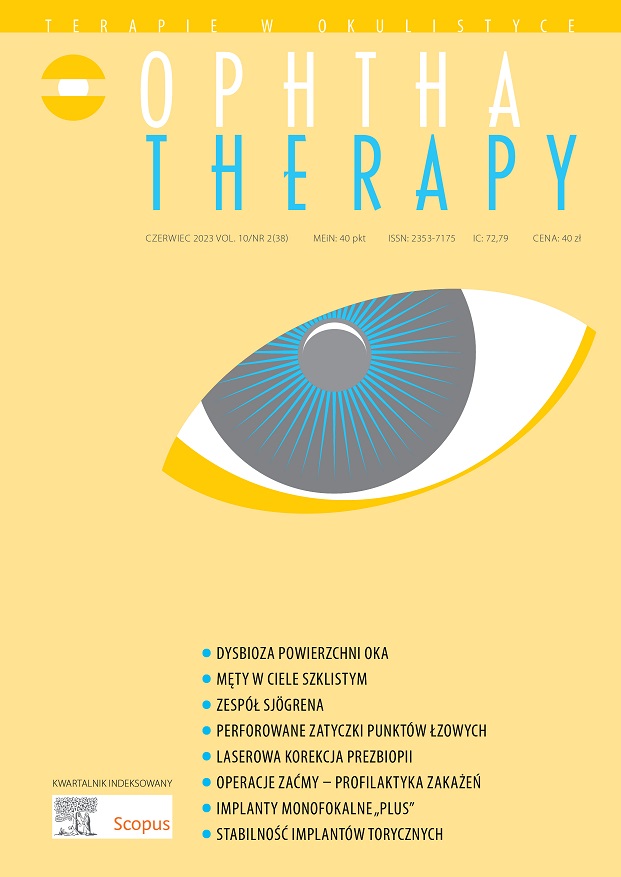Infections prophylaxis after cataract surgery: fluroquinolones and anti-inflammatory drugs – alone or in combined medications? Review article
Main Article Content
Abstract
Cataract surgery is one of the most commonly performed medical procedures. Currently, the most commonly used antibacterials after ophthalmic surgery are moxifloxacin and levofloxacin. Of the steroidal anti-inflammatory drugs, loteprednol etabonate or dexamethasone phosphate are commonly used. Due to the fact that the current guidelines recommend different durations of use of fluorquinolones (1–2 weeks) and glucocorticosteroids (3–4 weeks) in patients after cataract surgery, it seems justified to administer these drugs in separate preparations currently available on the market. There is a concern that the use of combination preparations may cause the patient to take fluoroquinolone for too long to maintain the anti-inflammatory effect of corticosteroids.
in the surgical site, and this may lead to the selection of resistant strains and increase the risk of adverse effects.
Downloads
Article Details

This work is licensed under a Creative Commons Attribution-NonCommercial-NoDerivatives 4.0 International License.
Copyright: © Medical Education sp. z o.o. License allowing third parties to copy and redistribute the material in any medium or format and to remix, transform, and build upon the material, provided the original work is properly cited and states its license.
Address reprint requests to: Medical Education, Marcin Kuźma (marcin.kuzma@mededu.pl)
References
2. Alberth M, Winwood D, Bodor N. Lipophilicity, solubility and permeability of loteprednol etabonate: a novel, soft anti-inflammatory corticosteroid. J Biopharm Sci. 1991; 2(2): 115-25.
3. Samudre SS, Lattanzio FA Jr, Williams PB et al. Comparison of topical steroids for acute anterior uveitis. J Ocular Pharm Ther. 2004; 20: 533-47.
4. Chen Y, Wang X, Gao M et al. The effect of loteprednol suspension eye drops after corneal transplantation. BMC Ophthalmol. 2021; 21(1): 234.
5. Sheppard JD, Comstock TL, Cavet ME. Impact of the topical ophthalmic corticosteroid loteprednol etabonate on intraocular pressure. Adv Ther. 2016; 33(4): 532-52.
6. Gaballa SA, Kompella UB, Elgarhy O et al. Corticosteroids in ophthalmology: drug delivery innovations, pharmacology, clinical applications, and future perspectives. Drug Deliv Transl Res. 2021; 11(3): 866-93.
7. Sharma T, Kamath MM, Kamath MG et al. Aqueous penetration of orally and topically administered moxifloxacin. Br J Ophthalmol. 2015; 99(9): 1182-5.
8. Torkildsen G, Proksch JW, Shapiro A et al. Concentrations of besifloxacin, gatifloxacin, and moxifloxacin in human conjunctiva after topical ocular administration. Clin Ophthalmol. 2010; 4: 331-41.
9. Kim DH, Stark WJ, O’Brien TP et al. Aqueous penetration and biological activity of moxifloxacin 0.5% ophthalmic solution and gatifloxacin 0.3% solution in cataract surgery patients. Ophthalmology. 2005; 112(11): 1992-6.
10. Bucci FA Jr, Nguimfack IT, Fluet AT. Pharmacokinetics and aqueous humor penetration of levofloxacin 1.5% and moxifloxacin 0.5% in patients undergoing cataract surgery. Clin Ophthalmol. 2016; 10: 783-9.
11. Gomes RLR, Viana RG, Melo LAS Jr et al. Aqueous humor concentrations of topical fluoroquinolones alone or in combination with a steroid. Arq Bras Oftalmol. 2017; 80(5): 300-3.
12. Figus M, Posarelli C, Romano D et al. Aqueous humour concentrations after topical application of combined levofloxacin-dexamethasone eye drops and of its single components: a randomised, assessor-blinded, parallel-group study in patients undergoing cataract surgery: the iPERME study. Eur J Clin Pharmacol. 2020; 76(7): 929-37.
13. Solomon KD, Sandoval HP, Potvin R. Comparing combination drop therapy to a standard drop regimen after routine cataract surgery. Clin Ophthalmol. 2020; 14: 1959-65.
14. Emami S, Kitayama K, Coleman AL. Adjunctive steroid therapy versus antibiotics alone for acute endophthalmitis after intraocular procedure. Cochrane Database Syst Rev. 2022; 6(6): CD012131.
15. O’Neill J. Tackling Drug-Resistant Infections Globally: Final Report and Recommendations. Review on Antimicrobial Resistance. Wellcome Trust and HM Government . Online.
16. Kato A, Horita N, Namkoong H et al. Prophylactic antibiotics for postcataract surgery endophthalmitis: a systematic review and network meta-analysis of 6.8 million eyes. Sci Rep. 2022; 12(1): 17416.
17. Grzybowski A, Kupidura-Majewski K. Znaczenie kropli antybiotykowych w profilaktyce okołooperacyjnej zapalenia wnętrza gałki po operacjach zaćmy. OphthaTherapy. 2019; 6(3): 147-51.
18. Miller KM, Oetting TA, Tweeten JP et al.; American Academy of Ophthalmology Preferred Practice Pattern Cataract/Anterior Segment Panel. Cataract in the adult eye preferred practice pattern. Ophthalmology. 2022; 129(1): P1-P126.
19. Barry P, Cordovés L, Gardner S. ESCRS guidelines for prevention and treatment of endophthalmitis following cataract surgery: data, dilemmas and conclusions 2013. Online.
20. Iwasaki T, Nejima R, Miyata K. Ocular surface flora and prophylactic antibiotics for cataract surgery in the age of antimicrobial resistance. Jpn J Ophthalmol. 2022; 66(2): 111-8.
21. Rizzo S, Gambini G, De Vico U et al. A one-week course of levofloxacin/dexamethasone eye drops: a review on a new approach in managing patients after cataract surgery. Ophthalmol Ther. 2022; 11(1): 101-11.
22. Nowakowska D, Krix-Jachym K, Rękas M et al. Antibiotic resistance in ophthalmology. Ophthalmol J. 2021; 6: 117-23.

